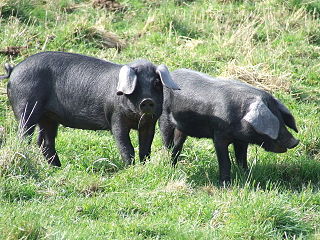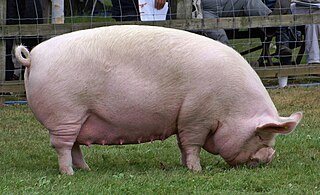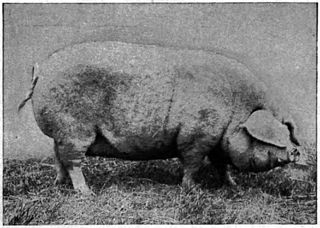Related Research Articles

A pig is any of the animals in the genus Sus, within the even-toed ungulate family Suidae. Pigs include domestic pigs and their ancestor, the common Eurasian wild boar, along with other species. Pigs, like all suids, are native to the Eurasian and African continents, ranging from Europe to the Pacific islands. Suids other than the pig are the babirusa of Indonesia, the pygmy hog of South Asia, the warthog of Africa, and another genus of pigs from Africa. The suids are a sister clade to peccaries.

The wild boar, also known as the "wild swine", "common wild pig", or simply "wild pig", is a suid native to much of Eurasia and North Africa, and has been introduced to the Americas and Oceania. The species is now one of the widest-ranging mammals in the world, as well as the most widespread suiform. It has been assessed as least concern on the IUCN Red List due to its wide range, high numbers, and adaptability to a diversity of habitats. It has become an invasive species in part of its introduced range. Wild boars probably originated in Southeast Asia during the Early Pleistocene and outcompeted other suid species as they spread throughout the Old World.

Breeding back is a form of artificial selection by the deliberate selective breeding of domestic animals, in an attempt to achieve an animal breed with a phenotype that resembles a wild type ancestor, usually one that has gone extinct. Breeding back is not to be confused with dedomestication.

The feral pig is a domestic pig which has gone feral, meaning it lives in the wild. They are found mostly in the Americas and Australia. In some countries, the terms razorback and wild hog are applied to feral pigs or boar–pig hybrids. These animals are different from the indigenous New World pigs such as peccaries (javelinas), but their ranges in the Americas overlap.

The Gloucestershire Old Spots is an English breed of pig which is predominantly white with black spots. It is named after the county of Gloucestershire. The Gloucestershire Old Spots pig is known for its docility, intelligence, and prolificity. Boars reach a mature weight of 600 lb (272 kg) and sows 500 lb (227 kg). The pigs are white with clearly defined black spots. There must be at least one spot on the body to be accepted in the registry. The breed's maternal skills enable it to raise large litters of piglets on pasture. Its disposition and self‑sufficiency should make it attractive for farmers raising pasture pigs and those who want to add pigs to diversified operations.

The Tamworth Two were a pair of pigs that escaped while being unloaded from a lorry at an abattoir in the English town of Malmesbury, Wiltshire in January 1998. The pigs were on the run for more than a week, and the search for them caused a huge media sensation, as well as immense public interest, both in Britain and abroad.

The Tamworth, also known as Sandy Back and Tam, is a breed of domestic pig originating in its namesake Tamworth, Staffordshire United Kingdom, with input from Irish pigs. It is among the oldest of pig breeds, but as with many older breeds of livestock, it is not well suited to modern production methods and is listed as "Threatened" in the United States and "Vulnerable" in the UK by the Rare Breeds Survival Trust, as fewer than 300 registered breeding females remain. This animal is of ginger to red colouration and is thought to have descended from wild boars, via native pig stock of Europe. Principal populations today are in the United Kingdom, Australia, the United States, New Zealand, and Canada.

The Bentheim Black Pied, also known as Schwarz-Wesses or Buntes Bentheimer Schwein, is a rare breed of domestic pig in Germany.

The Essex is a breed of domestic pig originating in the United Kingdom.

The Berkshire is a British breed of pig. It originated in the English county of Berkshire, for which it is named. It is normally black, with some white on the snout, on the lower legs, and on the tip of the tail.

The Shetland Islands of Scotland have long had their own distinct animal breeds, due to the remoteness of the archipelago. Below is a list of Shetland's domesticated animals.

The Large Black pig is a British breed of domestic pig. It is the only British pig that is entirely black. It was created in the last years of the nineteenth century by merging the black pig populations of Devon and Cornwall in the south-west with those of Essex, Suffolk and Kent in the south-east. It is hardy, docile and prolific; it forages well and is suitable for extensive farming, but not well suited to intensive management.

The Middle White is a breed of domestic pig native to the United Kingdom. It originated in Yorkshire roughly around the same time as the Large White. Its name comes from the fact that it was between the size of the Large White and the now-extinct Small White. It was fully recognized as a breed in 1884. The breed is known as a pork producer, and is best known for its sharply upturned snub nose. It is docile and often kept outdoors in grazing situations. Though its numbers have rebounded somewhat, the breed is listed as endangered by the Rare Breeds Survival Trust.

The Lincolnshire Curly Coat or Lincolnshire Curly-coated, also known as the Baston Pig, is an extinct British breed of domestic pig. It originated in, and was named for, the county of Lincolnshire, in the East Midlands. Like many other traditional pig breeds, it became rare after the Second World War. By 1970, it had disappeared. An older, still existing breed of similar looking pigs is the Hungarian Mangalica.
The Yorkshire Blue and White pig, also known as the Bilsdale Blue, or as the "Blood Breed", was a breed of domestic pig originating in the United Kingdom. It is now considered extinct.

The Small White or Small Yorkshire was a British breed of domestic pig, common during the nineteenth century. It is now extinct, but its characteristics were used in producing the Middle White and other breeds.
The Cumberland was a breed of domestic pig that originated in the North of England; it was used to produce local delicacies like the Cumberland sausage and Cumberland ham. The breed became extinct in 1960, after changes in farming methods and a demand for less fatty meat led to it falling out of favour.
The Chato Murciano is a breed of domestic pig originating from Murcia, Spain. It is the only surviving breed of pig locally and historically produced in Murcia and is at the risk of extinction. Despite its danger of becoming extinct, the Chato Murciano is a well-managed pig known for its production of bacon and lean pork. Several Spanish authorities specialising in agriculture work on programs aiming to conserve the breed by cross-breeding and artificial insemination

The Husum Red Pied is a rare breed of domestic pig with the nickname Danish Protest pig. It originates from North Frisia in Southern Schleswig in the beginning of the 20th century, when Danes living in the area under Prussian rule were prohibited from raising the Danish flag and displayed the Protest Pig instead. Due to its red color, its broad white vertical belt, and a trace of a white horizontal belt resembling the colors of the flag of Denmark, it was made a symbol of their cultural identity.
The Large White Ulster, or Ulster White, was a breed of domestic pig. Primarily bred for bacon production, it was the favoured breed of farmers in the north of Ireland up until the mid 20th century.
References
- ↑ Porter, V. Pigs: a handbook to the breeds of the world, Helm, 1993, p.99
- ↑ Robinson, G. M. Sustainable rural systems: sustainable agriculture and rural communities, Ashgate, 2008, p.85
- ↑ Farmers and Stock Breeders Year Book, 1961, p.252